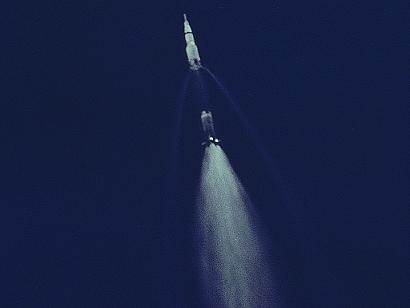Outside of the spacecraft during flight there the same amount of different process going on but the effect of what is happening is much more pronounced on the rockets flight path. When a rocket is flying through the air the most notable effects on it are that of
thrust from the engine, drag from air resistance, the force of gravity downward, and any turbulence from wind and pressure changes it may experience. Lets think of a rocket just having taken off straight up towards space, it would mathematically look something like this.
(ma = T - Fg - Fd) where T is Thrust, Fg is the force of gravity, and Fd is the drag.
Now as the rocket accelerates farther and farther away from earths surface it burns more fuel losing more and more mass making we already solved for the Thrust of a rocket with respect to time and mass lost so we can plug that in.
ma = -vpR - mg - 1/2CpAv2 this gives us our general equation for the forces acting on the outside of the rocket during flight.
During flight at some point when the mass of the fuel is empty it would be more efficient to remove excess weight, that's where staging comes in. Staging is a process used in most rockets to remove the extra weight of fuel containers and propulsion systems after they have been
completely used up to ensure the extra mass is not a hindrance in any way and improve the mass to thrust.
"Often times in a space mission, a single rocket cannot carry enough propellant (along with the required tankage, structure, valves, engines and so on) to achieve the necessary mass ratio to achieve the desired final orbital velocity (v)" [2]
